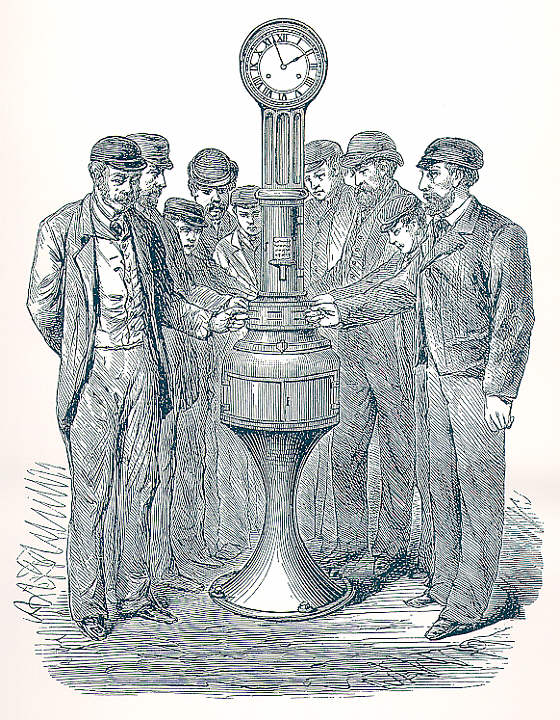Hochschule Augsburg
NTP Service
Motivation
Time is money. This is very true for industrial workers since
the middle of the 19th century. The check clock was the first
device for factory data collection and is used until today.
This woodcut was published in a german newspaper in 1889.
Reason
There is no real necessity to operate NTP servers
in our network, especially not for me. Even since
I became the head of the university computing center
(Rechenzentrum) this service is only - but now really -
nice to have.
As a member of the computer science department
(Fachbereich Informatik), I'm working on systems
for factory data collection (FDC),
namely personal attendance recording
and logistics data capturing.
Such systems require accurate time and date
to time-stamp each captured event record.
For this purpose the Network Time Protocol (NTP)
happens to be useful.
Suitability
Of course NTP's precision is pure overkill
for an FDC system. The ntpd daemon software
is rather 'fat' (according to its creator),
at least when run as a client.
But NTP is ready, complete, robust, simple to use and - free.
Reasons enough to use it for FDC. Here are even more:
NTP is available for today's favorite operating systems,
Unix in all its flavours and Microsoft Windows.
It supports many time sources like oscillators, GPS
and radio clock receivers, expensive and cheap ones.
It distributes time information to clients in IP networks.
'Lean' clients are also available using a variant,
the Simple Network Time Protocol SNTP.
Usage
Now we have it, let's use it!
First, our FDC servers are synchronized to UTC
(legal time) by NTP. The attached FDC devices,
like FDC terminals and barcode scanners, are
regularly supplied with time and date information.
Second, different server and workstation computers
in our network correct their system clock by NTP.
In a two stage process, the servers periodically
poll the NTP servers and the workstations synchronize
to a server.
Third, NTP can be useful for science and education.
Distributed multimedia and/or database applications
may exploit the full potential of NTP.
Fourth, we can offer stratum-2 NTP service for
peering and synchronization to contribute to the
world-wide NTP network.
Fifth, we become more experienced NTP operators.
In a consultant role, we could transfer
our knowledge to industry partners which intend
to set up and operate a NTP subnet of their own.
Last but not least, this accompanying web site is a
motivating exercise for web server administration,
html, CGI, Perl, and English language.
I apologize for any mistakes hurting native
English (or Perl) language speakers and invite you to
send corrections.
After all, you possibly can use the material
presented here for your own NTP installations,
as I benefitted from others before.
Information
2003-06-21

